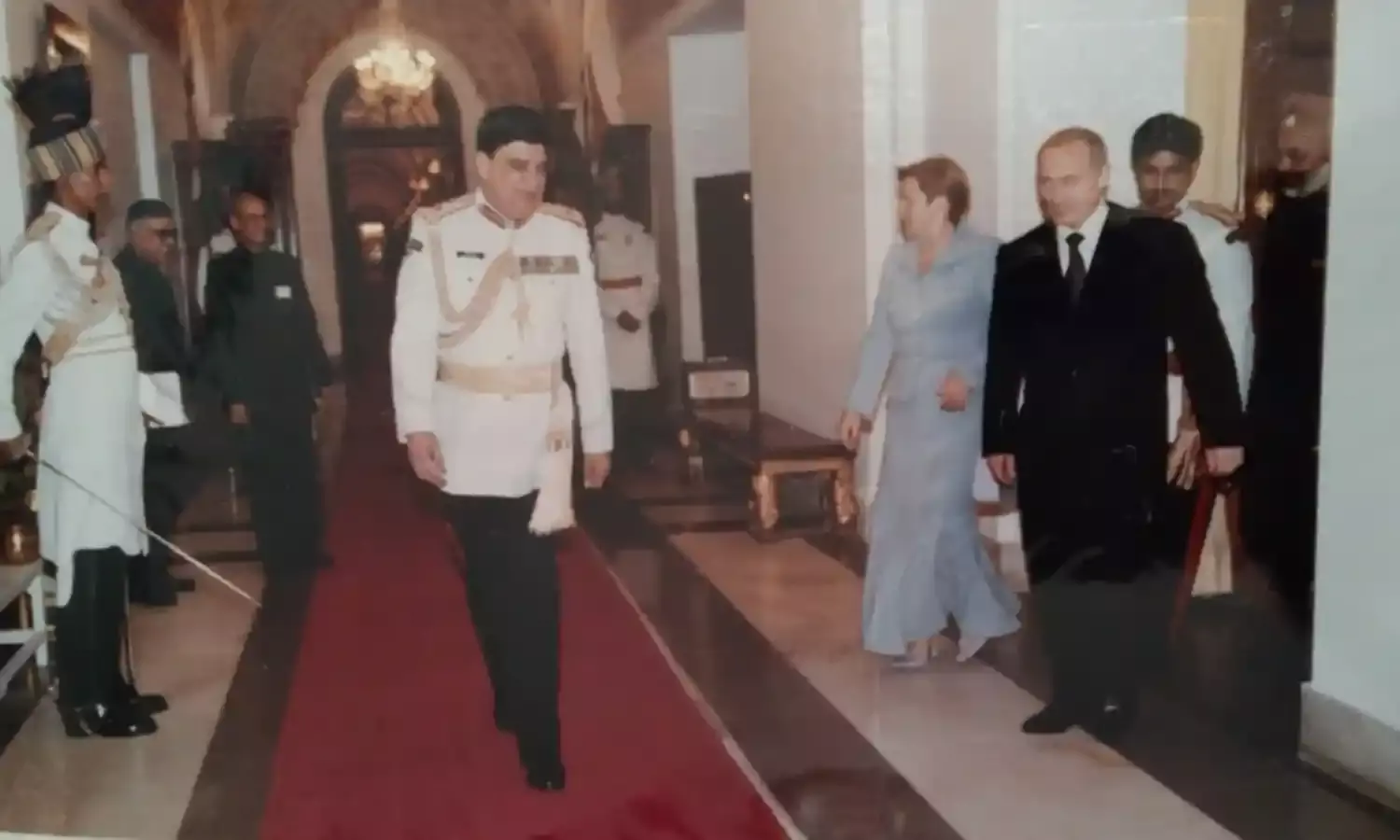
Soldiers are instinctively given to ‘one-count movement’ or salute, as the protocolled customs-and-courtesies, of those in the profession of arms.
The import of the same is especially freighted in ceremonial functions involving the sovereign, where the elaborate pomp-and-show is tastefully curated to reflect the grandeur, majesty, and values of the nation. As well as to show respect to the guests, such as the visiting heads of states.
In 75 years, Rashtrapati Bhawan has seen a host of global leaders in the form of Monarchs, democratically-elected Presidents/Prime Ministers, Dictators and Authoritarians to even Religious leaders of all possible denominations – each introduced to the unique splendour of India and the accompanying ‘Idea of India’.
One of the most memorable visits was that of Russian President Vladimir Putin, his first here in 2000.
Boris Yeltsin’s protégé and till recently spymaster of Federal Security Service (FSB or successor of KGB) turned Prime Minister, Vladimir Putin, had just got promoted to President. His brief stint as Prime Minister (Aug 1999 – May 2000) was an augury of Putin’s signature style of operating i.e., strong handed tactics.
Putin had done away with Yeltsin’s indecisive dilly-dallying in Chechnya and come hard in the Second Chechen War. Under Putin’s start, a familiar pattern was to be institutionalised – a full theatre invasion, heavy casualties (including civilian), media control and ultimately the imposition of a pliant leader to Moscow! International outcry notwithstanding,
Putin had brought back portents of the blunt Soviet leadership that had waned considerably, in the preceding Yeltsin-Gorbachev era. A relatively unknown, unsmiling, and pugnacious man had re emerged from the foreboding Russian Caucasus who behaved in the classical ‘Soviet’ mould, only instinctively, but not ideologically.
In those days, real giants of Indian civilisational-constitutional traditions inhabited the residences of Rashtrapati Bhawan and 7 Race Course (now, Lok Kalyan) – both occupants from differing partisan persuasions, but both with the highest possible integrity, belief and investment in the decency of democratic moorings.
The finest personification of the Indian experiment in democracy – President KR Narayanan, was a global statesman of unmatched erudition, former Ambassador to the USA, China, Japan, Vice Chancellor of JNU . Atal Bihari Vajpayee as Prime Minister was arguably the most sagacious, large-hearted and inclusive leader of his era.
Both had just navigated the vital correction of ‘imbalance’ in geopolitical/geostrategic equations by engaging with the USA, without sacrificing the Russian pivot. The team that delicately handled the strategic transition included Ministers like Jaswant Singh and Yashwant Sinha. Those were the days of issue management, and not headline management.
Rashtrapati Bhawan was versed with President Narayanan’s proclivity to add, embellish and support the national narrative with his own expressions (crafted after long and late hours in his office, with him chiseling and elevating the draft himself) – he could never be a proverbial ‘rubber stamp’ President, who’d stick to officialese and parrot the same.
President Narayanan added to every official ‘moment’, within the propriety and contours of constitutional mandate. The staff went about planning and implementing the minutest details, robotically, as it always did to ready Rashtrapati Bhawan to welcome the then fairly unknown President Putin.
The relatively short height on an unassumingly fit body, was more than made up by an unmistakable Russian ‘look’, presence and personality. The dour and soulless face with a purposeful walk, a gaunt and fairly rigid posture, the ‘above the law’ swagger that comes with unbridled power turned heads. He walked fast, faster than most country heads did – a man in a hurry, politically and personally.
Having been a man in uniform himself, Putin’s seemingly glazed expression would light up every time he saw the uniform amids the civilian brass that had lined up to receive him. I remember noticing, that the man who had transited from the KGB ‘Uniform’ to sharp civilian suits, was certainly more responsive with a slight smile, every time he was saluted by someone in ‘Uniform’, as opposed to the desultory handshakes and Namastes that came his way.
Certainly, while saluting him personally, I saw that same appreciative nod, an accommodative gesture even as his eyes took in every detail of my President’s Staff Uniform, with an unusually firm handshake and a vertical nod that is so familiar to those in ‘Uniform’.
Amongst almost all the national leaders that one had the opportunity to meet – Putin remains the most ‘muscular’ persona, confident and with an uneasy energy, restlessness and combativeness in his body language.
Perfunctory visits, reassuring agreements, statements and official banquets followed where an element of Russian bonhomie and ‘connect’ were present, but Putin retained a mysteriously aloof aura that was to be his trademark in the years to come.
He came again in 2002, a much more consolidated man but with the same mystery and rigid confidence - an authoritarian to the last.
Portents of that ruthless drive and untamed devil-may-care air about him, always existed. Today his cold eyes, shrugs, and brusque actions are on television in every Russian home and abroad. Seen favourably by many, and vilified in equal or greater measure, he re-stitches the neo-USSR dreams in Ukraine.
The memory of that fast paced, twitchy and the distant ‘man in hurry’ that we witnessed in 2000 (with his now divorced wife, Lyudmila Shkrebneva) has morphed into the stereotypical Russian Bear, intent on reclaiming a destiny, glory and territory, that he was lost with the collapse of the Soviet Union.

